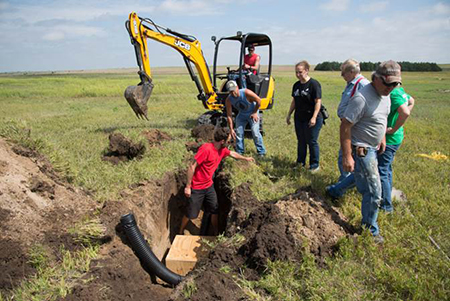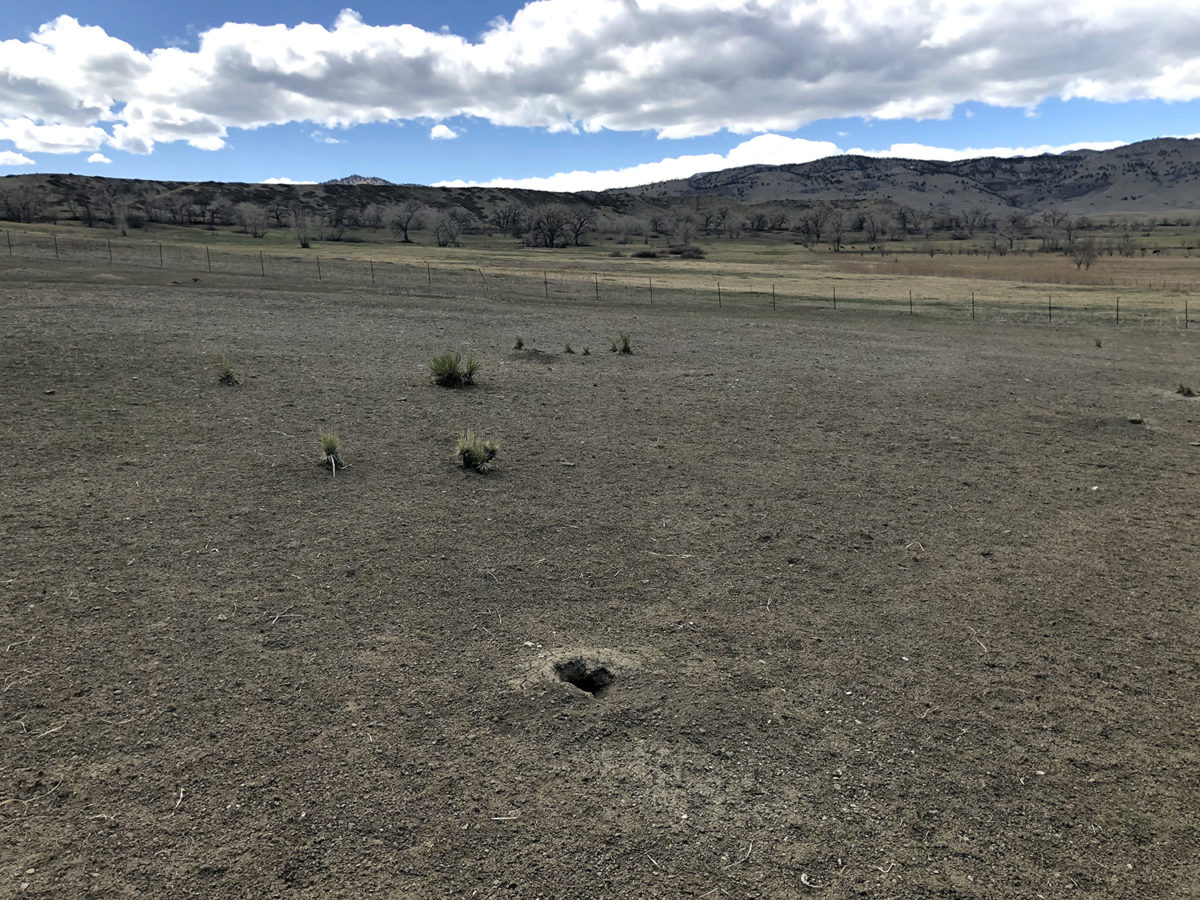By Linda P
As many of you may know we have a big problem on City of Boulder Open Space Agricultural Lands due to uncontrolled growth of prairie dogs. Our open space and agricultural lands have been under attack ever since Council voted to protect them over 10 years ago.
Left to continuously breed with no controls set in place, our open space agricultural lands are being ravaged, becoming unproductive and abandoned. Shown above is agricultural land at Boulder Valley Ranch Open Space, that only three to four years ago was a healthy, thigh-high grassland). It is becoming unsafe to operate farm machinery, hay yields are down, grazing lands gone, and growing of locally-sourced food becoming challenging (which we need now more than ever!)
We are also losing top soil, air quality is poor, invasive weeds increasing, and homeowners that adjoin these properties have been having to spend their time and money taking care of the City of Boulder Open Space prairie dog problem as colonies continue to grow, uncontrolled, and run onto their land. Many of us have been asking for Council to vote to expedite the process of lethal control before another pupping season. Unfortunately, last night Council decided to postpone any decisions on lethal control until September as COVID-19 ravages the world.
I share with you an update on where this issue stands from HEAL (Healthy Ecosystems and Agricultural Lands):
Short Version
- GOOD NEWS: OSMP staff supports OSBT’s recommendations and changes to their preferred alternative.
- SAD NEWS: There will be no staff action on the ag-land-destruction/PD issue until Council takes the issue up, and due to COVID-19, Council has postponed the ag-land-destruction/PD issue until late September.
The Long Version
OSMP staff supports OSBT’s recommendations and changes to their preferred alternative. On Monday March 30, 2020, HEAL representatives met with OSMP staff John Potter, Andy Pelster, Heather Swanson, Lauren Kolb, Mark Gersham and Alison Ecklund via an internet meeting. John Potter said that OSMP will:
- Conduct annual meetings with tenants and the public to evaluate success and review goal.
- Take the savings from NO conservation fund and NO live-trapping for Birds-of-Prey and apply them to PERC so they can lethally control more acre.
- Involve their Agricultural (AG) tenants as private contractors for removals.
- Support a rule change, special permit and ordinance change to allow lethal control and burrow destruction on parallel paths as expeditiously as possible.
At a meeting earlier in the day, staff told a tenant group that they planned on using PERC on up to 300 acres/year. Until they achieve their target objectives for PD occupancy in the Southern Grasslands, OSMP will continue to relocate 40 acres of PD’s (1200 animals) there annually. However, this is all contingent on OSMP having the budget to do all this, and everything is uncertain with sales tax revenues hammered from COVID-19. It was unclear how no money will impact their preferred alternative. Will relocations take precedence over everything else? Will PERC be used primarily since it is the most economical? All this is unknown.
There will be no staff action on the ag-land-destruction/PD issue until Council takes the issue up.
HEAL pushed staff on several things including supporting an emergency finding from the City Manager to allow burrow destruction and the killing of PD’s by agricultural tenants. OSMP staff pushed back hard against this and would not budge. Our hopes for some immediate relief for tenants or neighbors evaporated. Staff was unwilling to ask the City manager for emergency funding to allow burrow destruction, or more. Without this change, it will be impossible for tenants or neighbors to proceed with any of the inventive proposals you all have.
Staff also pushed back hard about keeping the Prairie Dog Working Group (PDWG) recommendations in their preferred alternative, even though they reluctantly admitted that there was not fair representation of the AG community in the PDWG. Staff reluctantly agreed that the 3% growth rate was not totally representative, and said that they might insert a range of growth rates. They also might rename “OSMP managed land” to “OSMP un-leasable irrigable land”. It became clear to us that nothing is going to happen until the ag-land-destruction/PD issue goes to City Council. We came away from this meeting quite discouraged.
Due to COVID-19, Council has postponed the ag-land-destruction/PD issue until late September.
Council was originally scheduled to take up the ag-land-destruction/PD issue at their April 21, 2020 meeting. Then COVID-19 struck. Council is now postponing all kinds of things, and our issue has been postponed until late September. It is likely subject to further postponement, depending on the severity of the pandemic and impacts to City finances.
In my Opinion
I believe the Prairie Dog Working Group should be investigated. We have spent a lot of taxpayer dollars to fund a group which so poorly represents the agricultural community. How were the individuals selected? Whose agenda are they really acting on? Why was the agricultural community not fairly represented? Why is OSMP and Council supporting the findings and suggestions from such a biased group? Why can’t County OSMP (who are acting) and City OSMP (who can’t seem to get their act together) work as one?
I also want to know why our Open Space lands are designated to be a ‘refugee city’ for every prairie dog. There are many un-fragmented grasslands across the west suitable for prairie dogs—and they are alive and well!
Outside of agricultural lands managed by OSMP, you should also be questioning:
OSMP is pushing to remove and realign trails at Gunbarrel Hill. While bragging about the highly-successful 20 year grassland reintroduction success (and is was), they have no lethal control planned on the four growing colonies, I wonder why we are spending any money on that at all. My guess is that within two years there will be NO grasslands left for any of the ground nesting birds they are trying to sell us on protecting—and they should be protected. I can’t imagine what those losses will have cost us and what they will cost the grasshopper sparrow! Plus, all those homeowner adjoining that open space better get on down to the gun shop or order your bait, as you will have to mitigate using your time and $$$ to keep the PD’s out of your backyards!



Relocation: stop wasting time, money and listening to the PDWG.
The action alone of relocation, the destruction of pristine land, the pesticide application and plastics you place into the ground to relocate PDs, and the costs are all highly questionable. The images shown here speak for themselves. Heavy equipment drives out on pristine grasslands, holes are dug and huge amounts of plastics are placed into the ground. Disturbed land welcomes invasive weeds and the plastics are not removed. Mortality rates high, costs high!
Do you think we should be investing all this time, or should we be working on saving our agricultural lands instead?
I have lost faith in our leaders and City of Boulder land managers—shame on you OSMP and City Council—you are quite possibly the worst land managers I have yet to see. You know my tax dollars pay your salaries and I an not happy on how you are spending the time and money!
I quote (as close as possible the words from one equestrian barn owner) from a past OSMP meeting, “OSMP, I don’t need a neighbor like you. If you can’t be a good neighbor and take care of the land then sell it!”
Links
Acres of barren Boulder soil are headed to rehab (and that might just help fight climate change) — The Colorado Sun
“As a neighbor, I’ve been hurt by the way they’re taking care of their land, and so have other farmers around here,” McCauley says. “You drive around, and the worst land is open space.”
Management Review of Irrigated Fields with High Prairie Dog Occupancy— Be Heard Boulder
Deltamethrin belongs to a group of pesticides called synthetic pyrethroids. This pesticide is highly toxic to aquatic life, particularly fish, and therefore must be used with extreme caution around water. Although generally considered safe to use around humans, it is still neurotoxic to humans.
What happens to deltamethrin in the environment?
When deltamethrin (Delta Dust) gets in the soil, it has a tendency to bind tightly to soil particles. It has a half-life ranging from 5.7- 209 days. Half-life is the measure of time it takes for half of the applied amount to break down. The half-life can change based on soil chemistry, temperature, water content and the amount of organic matter in the soil. Deltamethrin does not break down as quickly in soil with a high clay or organic matter content. Deltamethrin is broken down by microbes, light, and water. Its two major breakdown products move more easily in the soil than deltamethrin itself. —National Pesticide Information Center

